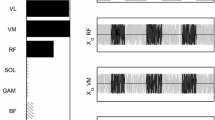Abstract
Muscular coordination analysis of lower limbs during rising from a squat is one of the important categories in rehabilitation engineering and gymnastic science. This paper describes an efficient biomechanical model of the human lower limb with the aim of simulating the real human rising from a squat with lifting. To understand how intermuscular control coordinates limb muscle excitations the optimal control technique is used to solve the muscle forces sharing problem. The validity of the model is assessed comparing the calculated muscle excitations with the registered surface electromyogramm (EMG) of the muscles. The results show that synergistic muscles are build up by the neural control signals using a minimum fatigue criterion during human squat lifting, with distinct phases that include the acceleration during the initial movement and the posture at the final specified position. Synergistic muscular groups can be used to simplify motor control, and are essential to reduce the number of controlled parameters and amount of information needing to be analyzed in the performance of any motor act.
Chapter PDF
Similar content being viewed by others
References
Crowninshield, R.D, Brand, R.A.: A physiologically based criterion of muscle force prediction in locomotion. J. Biomech. 14, 793–801 (1981)
Pandy, M.G.: Computer Modeling and Simulation of Human Move-ment. Ann. Rev. Biomed. Eng. 3, 245–273 (2001)
Yang, Y.Y.: Motion synergy and Control of Human Neuromusculoskeletal System. Ph.D. thesis, Tsinghua University, Beijing, China, pp. 66–88 (2004)
Anderson, F.C, Pandy, M.G.: Static and Dynamic Optimization Solutions for Gait Are Practically Equivalent. J. Biomech. 34, 153–161 (2001)
Pandy, M.G, Garner, B.A, Anderson, F.C.: Optimal Control of Non-ballistic Muscular Movements: A constraint-Based Performance Criterion for Rising From a Chair. J. Biomech. Eng. 117, 15–26 (1995)
Pedersen, D.R, Brand, R.A, Davy, D.T.: Pelvic Muscle and Acetabular Contact Forces During Gait. J. Biomech. 30, 959–965 (1997)
Rab, G.T.: Muscle. Human Walking. In: Rose, J., Gamble, J.G. (eds.) Williams and Wilkins, Baltimore, pp. 103–121 (1994)
Taga, G.: A Model of the Neuromusculoskeletal System for Human Locomotion: Emergence of Basic Gait. Biol. Cybern. 73, 95–111 (1995)
Author information
Authors and Affiliations
Editor information
Rights and permissions
Copyright information
© 2007 Springer-Verlag Berlin Heidelberg
About this paper
Cite this paper
Yang, Y., Wang, R., Zhang, M., Jin, D., Wu, F. (2007). Redundant Muscular Force Analysis of Human Lower Limbs During Rising from a Squat. In: Duffy, V.G. (eds) Digital Human Modeling. ICDHM 2007. Lecture Notes in Computer Science, vol 4561. Springer, Berlin, Heidelberg. https://doi.org/10.1007/978-3-540-73321-8_31
Download citation
DOI: https://doi.org/10.1007/978-3-540-73321-8_31
Publisher Name: Springer, Berlin, Heidelberg
Print ISBN: 978-3-540-73318-8
Online ISBN: 978-3-540-73321-8
eBook Packages: Computer ScienceComputer Science (R0)




